Puma (car manufacturer)
Puma is a sports car manufacturer based in South Africa. Puma was originally based in Brazil where it built cars, from 1964 until roughly 1995, and trucks, from 1978 to 1999. The company then re-opened in South Africa in 2013 under the name of Puma Automobiles. Puma Automobiles manufactures the Puma 52 (made especially for racing tracks) and the Puma GT 2.4 Lumimari.
| Puma | |
|---|---|
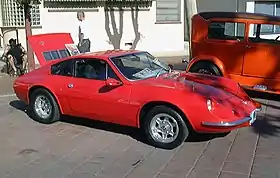 1977–1980 model Puma GTE | |
| Overview | |
| Manufacturer | Puma |
| Production | 1964–1995 2006–present (South Africa) |
| Assembly | São Paulo, Brazil Babelegi, South Africa |
| Body and chassis | |
| Body style | 2-door coupe 2-door roadster |
| Layout | RR layout |
| Related | Volkswagen Brasilia, Nissan S30, Opel GT |
In Brazil, Puma sourced engines from DKW (3 cylinders), Volkswagen (4 cylinders) and General Motors (4 and 6 cylinder) and mounted them on their own chassis and fiberglass bodies. A small number of cars were exported to US markets during the 1970s to the 1980s, but a more cost effective kit car option was responsible for the majority of US imports. The kit car variant was a complete car exported without the front suspension, transaxle, engine, wheels, and tires. The buyer could purchase the components from a Puma North American distributor or supply their own. Since it had less restrictive regulations, a greater number of complete cars were exported to buyers in Canada.[1]
Production of the first models started in 1964 using DKW components and a front engine, front wheel design. These models were sold and manufactured exclusively for auto racing. In 1967, the cars were redesigned for street use and featured an updated rear-mounted Volkswagen engine with a rear-wheel-drive design.
DKW era


The original Puma started out as a project known as DKW-Malzoni. They were built in 1964 by Genaro "Rino" Malzoni of Matão. Malzoni was a lawyer and an automotive enthusiast. At the request of DKW-Vemag, he developed a competition car based around a DKW straight-three, two-stroke engine. Malzoni built a steel-bodied prototype to compete with the Willys Interlagos—a locally built copy of the Alpine A108 which was outpacing DKW's heavier sedans. The prototype proved too heavy, but a new and lighter fiberglass GT debuted at the São Paulo Motor Show in the fall of 1964.[2] It won its first race that same year at Interlagos[3] and Malzoni founded the company Luminari Ltda with a group of other auto enthusiasts.[4] The competition cars had 1.1-litre engines with power output as much as 100 PS (74 kW).[5] The cars sold in quantities larger than Malzoni could produce on a small scale. The company adopted the Puma name and began mass production on September 14, 1966.[3]
Most models of the Malzoni GT featured a panoramic rear windshield, although a very small number were built with a three-box window design.[2] The original GT Malzoni body was modified by designer Anisio Campos, who made the car somewhat longer and mounted the bumpers higher up. The new design, which still used the DKW chassis, was named Puma GT. About 35 Malzoni GT cars were produced from 1964 to 1966.[5] Annual production increased to 125 for 1967 and continued briefly into 1968. As few as 170 of the first DKW-engined cars (Puma and Malzoni) were ever built.[2]
Volkswagen era

In 1967, Volkswagen (VW) bought DKW-Vemag and ceased production of the DKW engine in Brazil. With no DKW engines available, Puma designed a new car based on a shortened chassis of the rear-engined, air-cooled 1,500 cc Volkswagen Karmann Ghia sold in Brazil. The design, inspired by the Lamborghini Miura and Ferrari Dino 206 GT and 246 GT, remained largely unchanged for two decades.[6] The new design with a Volkswagen 1,600 cc engine was named the Puma 1600 GTE. It sold relatively well for a specialist sports car. Puma sold the 1600 GTE starting in 1969 and offered kits to make the engine more powerful.
A convertible version, the 1600 GTS, was added around 1970 and Puma began to export the cars to other South American countries, North America, and Europe. Most of the cars exported to North America were sold in kit form. However, all cars sold in Brazil were complete. In 1976 Volkswagen began to honor the warranty of their standard engine supplied to Puma. At the same time Puma introduced a three-month or 5,000 km warranty on their tuned engines and a 1.9-litre kit with Mahle pistons that had a bore and stroke of 88 mm × 78.4 mm.[7]
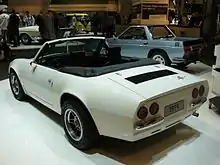
VW stopped production of the Karmann-Ghia in Brazil during the early 1970s so the Puma was redesigned in 1973 to use the Volkswagen Brasilia (VWB) as a base instead. During the same period, the Puma began to be assembled in South Africa by Bromer Motor Assemblies. Bromer Motor Assemblies produced 357 cars in two years but closed due to poor fiscal management.[3] The bodywork was restyled in 1977; while similar in appearance to the original, the bumpers were molded as part of the body, rather than attached as separate chrome units. The body was redesigned to be somewhat less rounded than before and the Coupé's louvers were replaced with rear quarter windows. The Puma models were restyled and renamed in 1980. The Coupé became the GTI and the Spider became the GTC. The new look included rubber bumpers with decorative cast-in ridges, which mimicked the Porsche 911 G's telescopic impact bumpers. The tail lights were replaced by the Volkswagen Brasilia's Mercedes-style units. The small push-button door handles were replaced with more modern units borrowed from the Alfa Romeo Ti 4.[8]

The P-018 model came out in 1982; it used a version of the VW Brasilia Variant II's more modern chassis with the Brasilia's front suspension. The P-018 had slightly wider front and rear tracks, and a rear suspension that featured semi-axles with constant-velocity joints, sprung by transverse torsion bars, rather than the Brasilia's simpler semi-trailing rear. As with other Puma models, an air-cooled 1.6-litre Volkswagen boxer-four was standard equipment, with larger 1.7-, 1.8-, and 2.0-litre versions available at extra cost.[9] An annual production of 1,000 was planned, but only about 55 of the P-018s were completed.
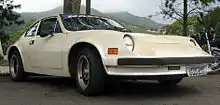
Other products
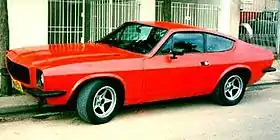

The larger Puma GTB (coupé only), which used a front-mounted Chevrolet straight-six engine, was not regularly exported. Puma also showed a few project cars over the years, such as the Mini-Puma city car in 1974, with a wheelbase of only 179 cm (70.5 in). The Mini-Puma would have been fitted with a halved Volkswagen 1500 boxer-four, with 760 cc and 30 PS (22 kW) engine.[10] However, Puma was unable to raise the funds needed for production. In 1982 Puma had plans to license-build the Daihatsu Cuore locally (also as the "Mini-Puma"), but failed due to the company's large debts and company mismanagement.[11]
Puma's trucks were of a fiberglass cab-over design, with proprietary diesel engines manufactured by MWM and Perkins (the 4.236 was a well known example). A Chevrolet inline-six, powered by ethanol, was also available for use on bus body models which were mounted on the same truck chassis.[12] The bodywork of the Puma truck was redesigned in 1978 for the 4.T model and there was also the six-ton, 6.T from 1979. After Alfa Metais took over the company, there were several new designs. All designs were largely based on the 4.T models. Production of the trucks came to a halt in 1999.
Puma designer Anisio Campos also designed the Dacon 828 city car in 1982. The first eleven of these cars were built at Puma's factory rather than by Dacon themselves.[13]
Decline and ownership change
The Puma factory was impacted by fires and floods and the harsh economic times of Brazil in the 1980s.[14] Production dropped from 400 cars per month during the company's peak in the 1970s to roughly 100 per year in 1985. Failure to meet production demands caused Puma to file for bankruptcy. In 1986, the rights to the Puma were sold to Araucária Veículos in Paraná, who made an attempt at revival but could not secure payment for VWB parts delivered.[15] Two years later the Puma tooling and rights were sold again, this time to Alfa Metais Veículos.
During the Alfa Metais period of ownership, the GTB was renamed to the AMV, while the small Puma cars were now called AM1 (Coupé) and AM2 (Spider). The AM1 and AM2 were actually a revived version of the 1983 and 1984 P 018, fitted with the VWB air-cooled 1,584 cc flat-four.[16] With reduced power of 44 PS (32 kW) and a top speed of only 140 km/h (87 mph), the car lost most of its sporting pretensions.[17] The AM3 and AM4 were introduced in 1989 with a considerably more powerful, water-cooled Volkswagen AP1800 engine. The radiator was placed in the rear and weight distribution and handling suffered as a result.[14] Production continued in small numbers but when the Brazilian market opened to foreign cars in the early 1990s, Puma's Brazilian factory closed. The last Puma sports car was an AM4, sold in 1995. Only about forty AM3s and AM4s were built.
South African revival
The Puma had been imported into South Africa after 1986, but after costs became prohibitive, the importer bought the molds to the 1973 Puma 1600 GTE and began to build them locally. Jack Wijker's Puma Marketing company finished twenty-six cars between 1989 and 1991. Some of the later cars were built with rear quarter windows instead of louvres behind the rear door.[3] Limited production of the Puma was restarted in 2006 in South Africa.
Malzoni and Marques
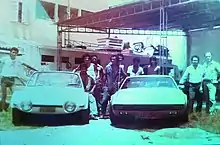
The Malzoni family (nephew Kiki) later revived the brand, building around 40 Malzoni GT in the 1970s. This was the first Brazilian car to be equipped with pop-up headlights.[18] This car was later also built by a company called Marques in very small numbers.
| Wikimedia Commons has media related to Puma vehicles. |
Production
| Year | Production | Year | Production |
|---|---|---|---|
| 1966 | 1976 | ||
| 1967[3] | 125 | 1977 | |
| 1968 | 1978 | ||
| 1969 | 1979 | ||
| 1970 | 1980 | ||
| 1971 | 1981 | ||
| 1972[3] | 484 | 1982[19] | around 450 |
| 1973[3] | 769 | 1983 | |
| 1974[4] | 1,137 | 1984 | |
| 1975 | 1985 | ||
References
- "Puma GT 1600 Coupe". Motor1. Mar 25, 2016. Archived from the original on 2018-08-19. Retrieved 2018-08-18.
- Hundt, Michael (December 2011). "Samba im Zweitakt" [Two-stroke Samba]. Oldtimer Markt (in German): 30–31. Archived from the original on 2013-12-13. Retrieved 2012-10-09.
- Price, Ryan Lee (April 2003). "The Story Behind the Puma". VW Trends: 38. Archived from the original on 2013-12-12. Retrieved 2012-10-09.
- World Cars 1976. Bronxville, NY: L'Editrice dell'Automobile LEA/Herald Books. 1976. p. 412. ISBN 0-910714-08-8.
- Hundt, pp. 32-33 Archived 2013-12-12 at the Wayback Machine
- Castaings, p. 2 Archived 2012-10-28 at the Wayback Machine
- "A Puma garante seus venenos - até 1900 cc" [Puma guarantees their tuned ones - now up to 1,900 cc]. Oficina Mecânica (in Portuguese): 14. November 1976. Archived from the original on 2018-05-19. Retrieved 2012-10-08.
- Nicoliello, Felipe (2008-12-03). "Puma GTI / GTC". Puma Classic (in Portuguese). Archived from the original on 2012-05-03. Retrieved 2012-10-09.
- "Puma Novo P0 18 (sic)" [The new Puma P 018]. Quatro Rodas (in Portuguese): 45. 1981. Archived from the original on 2018-05-19. Retrieved 2012-10-08.
- World Cars 1976, p. 255. 760cc is listed, although at 83x69mm it would have had a 747cc displacement.
- Castaings, p. 3 Archived 2012-10-31 at the Wayback Machine
- Puma 6.T: Ônibus e Caminhões [Puma 6.T: Bus and Truck] (brochure) (in Portuguese), Puma Indústria de Veículos S/A, p. 2, archived from the original on 2015-04-02
- Negyesi, Pal. "Dacon 828". KTUD Automotive Web. Archived from the original on 2011-12-16. Retrieved 2012-10-10.
- Castaings, p. 4 Archived 2012-09-19 at the Wayback Machine
- Viotti, Eduardo (October 1988). "Puma AM-1". Oficina Mecânica (in Portuguese). Sigla. 3 (28): 50. Archived from the original on 2013-12-13. Retrieved 2012-10-08.
- Viotti, pp. 48-49 Archived 2016-03-04 at the Wayback Machine
- Viotti, p. 51 Archived 2018-05-19 at the Wayback Machine
- Malzoni, Francisco. "As feras: Puma, Onça e Carcará" [The beast: Puma, Onça and Carcará]. rinomalzoni.com (in Portuguese). Archived from the original on 2019-04-25.
- Lösch, Annamaria, ed. (1985). World Cars 1985. Pelham, NY: The Automobile Club of Italy/Herald Books. p. 407. ISBN 0-910714-17-7.
Further reading
- Castaings, Francis. "O felino brasileiro" [Brazil's Feline]. Páginas da História [Historic Pages] (in Portuguese). Best Cars Web Site. Retrieved 2012-10-08.
- Braun, Thomas (2011). Puma: Typen und Geschichte (in German). BoD – Books on Demand. ISBN 9783842340299.